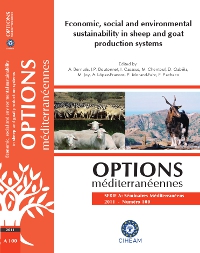| Article précédent | p. 267-273 | Article suivant |
Evaluation et amélioration des systèmes de production ovins et caprins par la méthode des blocs-diagnostics
Lorsque l'agent de développement a identifié les systèmes de production ovine et caprine de sa zone d'activité, il doit, après avoir collecté les enregistrements techniques et économiques effectués par les éleveurs, élaborer un diagnostic ayant pour objectif d'améliorer leurs résultats. Le diagnostic technique, puis économique, après une analyse structurelle des moyens de production, sans négliger l'influence des facteurs environnementaux, peut être facilité par la constitution de blocs-diagnostics. Cette méthode consiste à réunir les indicateurs, d'une part, techniques : sélection, reproduction, alimentation, pathologie... d'autre part, économiques : prix de vente des produits, charges variables et fixes, marges... La comparaison de ces regroupements de résultats doit permettre de détecter les points forts ou faibles de la gestion de ces systèmes de production et de faire des propositions d'amélioration dans les domaines quantitatifs et qualitatifs, basées sur un suivi technico-économique mensuel reposant sur la méthode prévu-réalisé. Cette méthode d'analyse exige de disposer de références techniques et économiques issues soit de l'analyse de groupe, soit de bases de données régionales, permettant de sélectionner des indicateurs à partir d'analyses statistiques, d'établir les liaisons entre eux et les indicateurs-objectifs concernant les résultats, pour les regrouper en blocs-diagnostics.
First the extension agents identify the sheep and goat production systems in the zone of his responsibility. Then, after having collected the technical and economic records from the breeders, they have to propose a diagnosis to improve their technical and economic results. The technical and economic diagnosis after analysing the structures of the production means, without neglecting the influence of the environmental factors, can be facilitated by the implementation of -diagnostic blocks. This method gathers technical indicators on one hand, such as selection, reproduction, feeding, pathology, etc. and on the other hand, economic indicators such as the selling price of products, variable and fixed expenses, margins, etc. The comparison of these pooled results must enable the positive or negative aspects to be detected in the management of these production systems. It also allows to an improvement in the quantitative and qualitative fields to be proposed based on a technical and economical monthly follow-up based on a planned-realized method. This method of analysis requires technical and economic references provided either by the group analysis, either from regional data bases, allowing some indicators to be selected from statistical analyses, to establish the links between them and the indicators-objective concerning the results, to pool them into diagnostic blocks-.
- [ Afficher ]
- [ Télécharger ]
- [ Exporter la citation ]
Vous pouvez télécharger la citation au format :
- [ Imprimer ]
-
Mots-clés
CAPRIN, CONDUITE D'ELEVAGE, EVALUATION, INDICATEUR, METHODE, OVIN, RESULTAT DE L'EXPLOITATION AGRICOLECiter cet article
Toussaint G.-C. Evaluation et amélioration des systèmes de production ovins et caprins par la méthode des blocs-diagnostics. In : Bernués A. (ed.), Boutonnet J.P. (ed.), Casasús I. (ed.), Chentouf M. (ed.), Gabiña D. (ed.), Joy M. (ed.), López-Francos A. (ed.), Morand-Fehr P. (ed.), Pacheco F. (ed.). Economic, social and environmental sustainability in sheep and goat production systems. Zaragoza : CIHEAM / FAO / CITA-DGA, 2011. p. 267-273. (Options Méditerranéennes : Série A. Séminaires Méditerranéens; n. 100). 7. Proceedings of the International Seminar of the Sub-Network on Production Systems of the FAO-CIHEAM Inter-Regional Cooperative Research and Development Network on Sheep and Goats, 2010/11/10-12, Zaragoza (Spain). http://om.ciheam.org/om/pdf/a100/00801514.pdf



